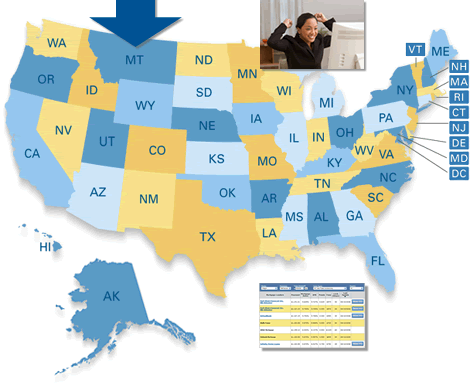Reverse Mortgages
Refinance
Reverse Mortgages Today: A Specialized Product in a Recovering Market
by Amy Lillard
(8/2/2012) In the boom times of the real estate market just a few short years ago, reverse mortgages tapping the equity of a home were a popular loan option for older borrowers. But since the peak of 115,000 reverse mortgage originations before the financial crisis, the market has shrunk considerably.
As the market slowly inches towards recovery, consumer agencies and lenders are noting more inquires about reverse mortgages. But besides denoting market growth, renewed interest in the reverse mortgage market casts a revealing light on some disturbing trends among seniors.
What are reverse mortgages? These products represent a very specialized area of the housing market, one designed for a specific population. For many homeowners, the most valuable asset they own is their home. But that asset does not provide regular income. For seniors 62 and older who are facing less income at retirement, and longer lives that may involve increased healthcare costs, borrowing against their most valuable asset can provide liquid cash to supplement income and cover costs.
In many ways, reverse mortgages are similar to home-equity lines of credit. But with these mortgages, no payments are due until the borrower’s death or the sale of the house.
Reverse mortgages can sound like a great solution to a cash-poor situation. But there are some things that can cause the picture to darken. Property taxes are still due, and homeowners insurance is still required over the life of the loan. And while there are no monthly payments on the loan, the interest continues to accrue, adding to the loan balance each month. That means the loan balance can easily grow to exceed the value of the home. Finally, upfront fees, interest and closing costs can be much higher than normal loans and other home equity loans.
In the painful years since the housing market collapse where home values dropped sharply, reverse mortgages became a luxury that many could not longer consider. The number of reverse mortgage borrowers and lenders plunged.
But as the market slowly recovers, reverse mortgages are suddenly growing in popularity. Lenders are beginning to sell these products again: Impac Mortgage Holdings, which nearly died from the subprime crisis, launched a new lending channel this year that again offers reverse mortgages, and big players like MetLife have pushed production higher.
And when it comes to borrowers? There are some interesting, and potentially troublesome, trends as reverse mortgages gain in popularity, according to a report by the Consumer Financial Protection Bureau. The number of seniors taking out a reverse mortgage at the first opportunity of age 62 jumped to 9 percent in 2011, up from 2 percent during the 1990s. Plus, about 70% of customers in 2011 took the loan’s funds in a lump sum instead of regular payments. That number has skyrocketed since 2008, when 40% elected for lump sum payment.
Why is this happening? Today baby boomers are reaching retirement in droves, and are struggling to pay for it. Reduced social security and the economic woes of recent years makes retirement a costly proposition. It’s natural then that the popularity of reverse mortgages is growing, especially among those under 70.
But the increased tendency to take payments in a lump sum is causing problems for some seniors. Many use the funds to pay off other debt. That leaves little left for the property taxes and insurance that are still due, or the other costs that pop up during retirement.
The Bureau cited a series of concerns in their report due to these new trends, including a lack of education on reverse mortgage products by lenders, downright deceptive marketing practices, and lack of counseling to borrowers.
“Though many Americans are aware of reverse mortgages, they struggle greatly to understand this complicated product and the trade-offs involved,” said Richard Cordray, director of the consumer bureau in the report. “People often have misconceptions about how their needs may change as they age in their homes. Some are unaware that a reverse mortgage is a loan, let alone one with negative amortization, as the loan balance rises over time.”
The new trends in reverse mortgages present reasons for borrowers to be wary. At the same time, reverse mortgages have always been a risky gamble for borrowers and their family, and these dangers still apply. Seniors who fail to pay property taxes or insurance can default on the loan, which can ultimately end in foreclosure. Plus, when a borrower dies, dependents or others living in the house are responsible for paying the loan, which may have ballooned to much more than the value of the home due to interest. And if dependents, spouses, or others in the house are not listed on the loan, they may be forced to leave the house when the borrower dies.
The regrowth of the reverse mortgage market is potentially one sign of the housing market’s slow recovery. But it’s also a product to be careful with, especially with new trends and economic realities. In fact, many financial planners urge using reverse mortgages only as an emergency line of credit, or having the payments stretched out monthly to last longer. All in all, borrowers considering reverse mortgages should know all the rules and risks before making the choice.
Other Articles:
Reverse mortgage criticism, rebuttals coming to a head
Is a reverse mortgage for you?
Reverse Mortgages: Look hard before you leap
Reverse Mortgages: The debate heats up
Reverse mortgages slated for regulatory overhaul
Reverse Mortgage Program Facing Cutbacks
Refinance at Today's Low Rates!
Fannie Mae & Jumbo Mortgage Rates
Just One Click! = Current Rate Chart


